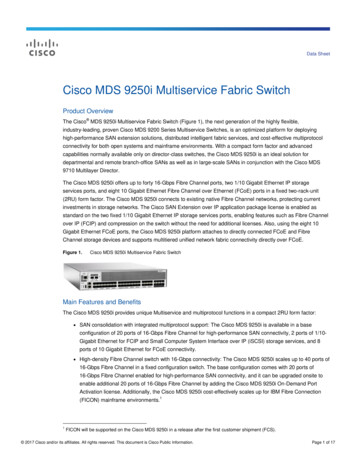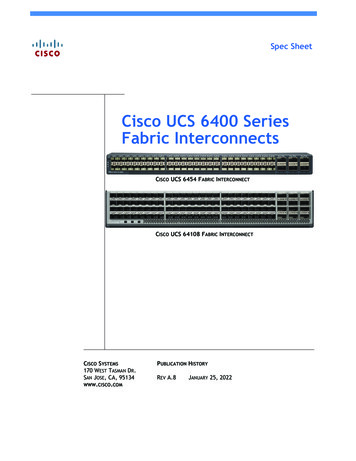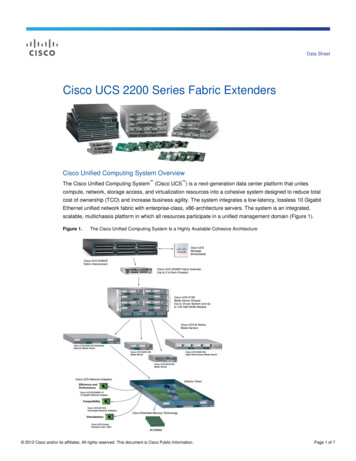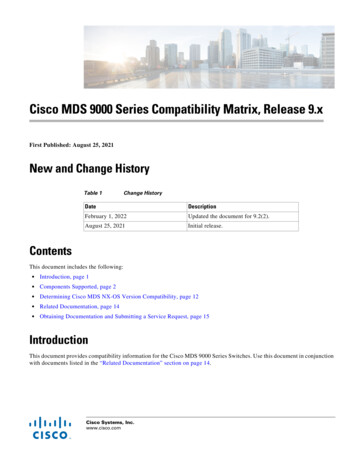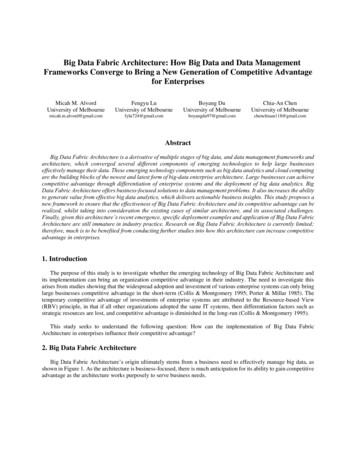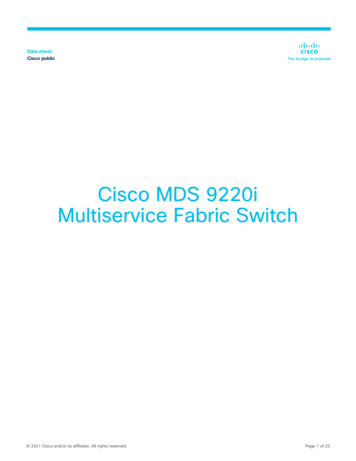
Transcription
Data sheetCisco publicDCisco MDS 9220iMultiservice Fabric Switch 2021 Cisco and/or its affiliates. All rights reserved.Page 1 of 20
ContentsProduct overview3Product specifications10Ordering information16Product sustainability19Cisco Capital19Document history20 2021 Cisco and/or its affiliates. All rights reserved.Page 2 of 20
Cisco MDS 9220i FCIP switch enables customers to implement high-performance SANextension solutions, cost-effective multiprotocol connectivity, and distributed intelligentfabric services for both open systems and mainframe environments.Product overviewCisco MDS 9220i Multiservice Fabric Switch (Figure 1), the next generation of the highly flexible, industryleading, proven Cisco MDS 9200 Series Multiservice Switches, is an optimized platform for deploying highperformance SAN-extension solutions, distributed intelligent fabric services, and cost-effective multiprotocolconnectivity for both open systems and mainframe environments. With a compact form factor and advancedcapabilities, the Cisco MDS 9220i is an ideal solution for departmental and remote branch-office SANs as wellas in large-scale SANs in conjunction with Cisco MDS 9700 Series Multilayer Directors.The Cisco MDS 9220i offers up to twelve 32-Gbps Fibre Channel ports, four 1/10-, two 25-, and one 40Gigabit Ethernet IP storage services ports, in a fixed One-Rack-Unit (1RU) form factor. The Cisco MDS 9220iconnects to existing native Fibre Channel networks, protecting current investments in storage networks. TheCisco SAN Extension over IP application package license is enabled as standard on the two fixed 1/10 GigabitEthernet IP storage services ports, enabling features such as Fibre Channel over IP (FCIP) and compression onthe switch without the need for additional licenses.Figure 1.MDS 9220i SwitchMain features and benefitsThe Cisco MDS 9220i Multiservice Fabric Switch provides unique multiservice and multiprotocol functions in acompact 1RU form factor: SAN consolidation with integrated multiprotocol support: The Cisco MDS 9220i is available in a baseconfiguration of four ports of 32-Gbps Fibre Channel for high-performance SAN connectivity and twoports of 1/10-Gigabit Ethernet for FCIP storage services, running at a max speed of 1-Gbps. SAN switch with 32-Gbps connectivity in 1RU form factor: The Cisco MDS 9220i scales up to 12 portswith speeds up to 32-Gbps Fibre Channel in a fixed configuration switch. The base configuration comeswith four ports of 32 Gbps Fibre Channel enabled for high-performance SAN connectivity, and it can beupgraded on site and online to enable an additional eight ports of 32-Gbps Fibre Channel by adding theCisco MDS 9220i on-demand upgrade license. The upgrade license also enables 10 Gigabit speed onthe initial two Ethernet ports, two additional 1/10 Gigabit ports, two 25 Gigabit ports, and one 40 Gigabitport. Flexible FCIP port speed: in line with recent industry trends, the Cisco MDS 9220i provides flexibleconnectivity options toward datacenter switches, routers or DWDM systems, including 25G speed. Boththe 25G and 40G options can be very valuable for data with a lower level of compressibility, while the 1and 10G options can well satisfy the needs of small-medium organizations. 2021 Cisco and/or its affiliates. All rights reserved.Page 3 of 20
IBM Fibre Connection support: Cisco MDS 9220i cost-effectively scales up for IBM Fibre Connection(FICON) mainframe environments.1 Intelligent application services engine: The Cisco MDS 9220i includes, as standard, a single applicationservices engine that enables the included Cisco SAN Extension over IP software solution package to runon the two or more 1/10/25 or 40 Gigabit Ethernet storage-services ports. The Cisco SAN Extensionover IP package provides an integrated, cost-effective, and reliable business-continuance solution thatuses IP infrastructure by offering FCIP for remote SAN extension, along with a variety of advancedfeatures to optimize the performance and manageability of FCIP links. Hardware-based virtual fabric isolation with Virtual SANs (VSANs) and Fibre Channel routing with InterVSAN Routing (IVR): VSANs and IVR enable deployment of large-scale multisite and heterogeneous SANtopologies. Integration into port-level hardware allows any port in a system or in a fabric to bepartitioned into any VSAN. Included in the optional Cisco MDS 9000 Family Enterprise advancedsoftware package, IVR provides line-rate routing between any of the ports in a system or in a fabricwithout the need for external routing appliances. Remote SAN extension with high-performance FCIP: Simplifies data protection and business-continuance strategies by enabling backup, remotereplication, and other disaster-recovery services over WAN distances using open-standards FCIPtunneling. Optimizes utilization of WAN resources for backup and replication by enabling hardware-basedcompression, hardware-based encryption, FCIP write acceleration, and FCIP tape read-and-writeacceleration; up to 12 virtual Inter-Switch Link (ISL) connections are provided on the Ethernet portsthrough tunneling (3 tunnels for 1/10G or 4 tunnels for 40G IPS ports). Leverages a powerful service engine chipset coupled with optimized software stack to push up to40Gbps of traffic on the WAN link Preserves Cisco MDS 9000 Family enhanced capabilities, including VSANs, IVR, advanced trafficmanagement, and network security across remote connections. Advanced FICON services:2 The Cisco MDS 9220i will support FICON environments, including cascadedFICON fabrics, VSAN-enabled intermix of mainframe and open-systems environments, and N-Port IDVirtualization (NPIV) for mainframe Linux partitions. IBM Control Unit Port (CUP) support enables in-bandmanagement of Cisco MDS 9200 Series Multiservice Switches from the mainframe managementconsole. FICON tape acceleration reduces latency effects for FICON channel extension over FCIP forFICON tape read-and-write operations to mainframe physical or virtual tape. This feature is sometimesreferred to as tape pipelining. Platform for intelligent fabric applications: The Cisco MDS 9220i provides an open platform that deliversthe intelligence and advanced features required to make multilayer intelligent SANs a reality, includinghardware-enabled innovations to host or accelerate applications for data migration, storage backup, anddata replication. Hosting or accelerating these applications in the network can dramatically improvescalability, availability, security, and manageability of the storage environment, resulting in increasedutility and lower Total Cost of Ownership (TCO).1IBM FICON support is available in one Cisco NX-OS release after the first customer shipment of Cisco MDS 9220i.2FICON and related features will be supported on the Cisco MDS 9220i in a post-FCS release. 2021 Cisco and/or its affiliates. All rights reserved.Page 4 of 20
Intelligent network services: Cisco MDS 9220i uses VSAN technology for hardware-enforced, isolatedenvironments within a single physical fabric, Access Control Lists (ACLs) for hardware-based intelligentframe processing, and advanced traffic management features such as fabric-wide Quality of Service(QoS) to facilitate migration from SAN islands to enterprise-wide storage networks. High-performance ISLs: Cisco MDS 9220i supports up to 12 Fibre Channel ISLs in a single port channel.Up to 8191 extended buffer-to-buffer credits (the default is 500) can be assigned to a single FibreChannel port to extend storage networks over long distances. Comprehensive network security framework: The Cisco MDS 9220i supports RADIUS and TACACS ,LDAP, Secure File Transfer Protocol (SFTP), Secure Shell (SSH) Protocol, Simple Network ManagementProtocol Version 3 (SNMPv3) implementing Advanced Encryption Standard (AES), VSANs, hardwareenforced zoning, ACLs, and per-VSAN Role-Based Access Control (RBAC). Additionally, the IPS portsoffer IP security (IPsec) authentication, data integrity, and hardware-assisted data encryption for FCIP. IP Version 6 (IPv6) capable: The Cisco MDS 9220i supports IPv6 as mandated by the U.S. Department ofDefense (DoD), Japan, and China. IPv6 support is provided for FCIP, and management traffic routed inband and out of band. FIPS compliance: The Cisco MDS 9220i will be FIPS 140-2 compliant as mandated by the U.S. federalgovernment. Sophisticated diagnostics: The Cisco MDS 9220i provides intelligent diagnostics, protocol decoding, andnetwork-analysis tools as well as integrated Cisco Smart Call Home capability for added reliability, fasterproblem resolution, and reduced service costs.VSANVSANs are ideal for efficient, secure SAN consolidation, enabling more efficient storage network utilization bycreating hardware-based isolated environments with a single physical SAN fabric or switch. Each VSAN can bezoned as a typical SAN and maintains its own fabric services for added scalability and resilience. VSANs allowthe cost of SAN infrastructure to be shared among more users, while helping ensure complete segregation oftraffic and retaining independent control of configuration on a VSAN-by-VSAN basis.IVRIn another step toward deploying efficient, cost-effective, consolidated storage networks, the Cisco MDS 9220isupports IVR, the industry’s first routing function for Fibre Channel. IVR allows selective transfer of databetween specific initiators and targets on different VSANs while maintaining isolation of control traffic withineach VSAN. With IVR, data can transit VSAN boundaries while maintaining control plane isolation, therebymaintaining fabric stability and availability. IVR is one of the feature enhancements provided with the Cisco MDS9000 Family Enterprise software license and eliminates the need for external routing appliances, greatlyincreasing routing scalability while delivering line-rate routing performance, simplifying management, andeliminating the challenges associated with maintaining separate systems. Deploying IVR means lower total costof SAN ownership. 2021 Cisco and/or its affiliates. All rights reserved.Page 5 of 20
FCIP for remote SAN extensionData distribution, data protection, and business continuance services are significant components of today’sinformation-centric businesses. The capability to efficiently replicate critical data on a global scale not onlyhelps ensure a higher level of data protection for valuable corporate information, but also increases utilization ofbackup resources and lowers total cost of storage ownership. Building on Cisco expertise and knowledge of IP networks, the Cisco MDS 9220i switch uses openstandards FCIP to break the distance barrier of current Fibre Channel solutions, enabling interconnectionof SAN islands over extended distances. The Cisco MDS 9220i dramatically enhances hardware-based FCIP compression performance for bothhigh-bandwidth and low-bandwidth links, providing immediate cost savings for expensive WANinfrastructure. The Cisco MDS 9220i achieves up to a 43:1 compression ratio, with typical ratios of 4:1 to5:1 over a wide variety of data sources. The Cisco MDS 9220i supports hardware-based IPsec encryption for secure transmission of sensitivedata over extended distances. Hardware enablement of IPsec helps ensure high throughput. Usedtogether, hardware-based compression and hardware-based encryption provide high-performance,highly secure SAN extension capabilities.Mainframe support3The Cisco MDS 9220i is mainframe ready and will support IBM zSeries FICON and Linux environments providedwith the Cisco MDS 9000 Mainframe advanced software package. To be qualified by IBM for attachment to allFICON-enabled devices in an IBM zSeries operating environment, Cisco MDS 9220i switches will supporttransport of the FICON protocol in both cascaded and noncascaded fabrics, as well as an intermix of FICON andopen-systems Fibre Channel Protocol traffic on the same switch. VSANs simplify intermixing of SAN resourcesamong IBM z/OS, mainframe Linux, and open-systems environments, enabling increased SAN utilization andsimplified SAN management. VSAN-based intermix mode eliminates the uncertainty and instability oftenassociated with zoning-based intermix techniques. VSANs also eliminate the possibility that a misconfigurationor component failure in one VSAN will affect operation in other VSANs. VSAN-based management accesscontrols simplify partitioning of SAN management responsibilities between mainframe and open-systemsenvironments, enhancing security. FICON VSANs can be managed using the standard Cisco Data CenterNetwork Manager (DCNM), the Cisco Command-Line Interface (CLI), or IBM CUP-enabled management tools,including SA/390, Resource Measurement Facility (RMF), and Dynamic Channel path Management (DCM).The Cisco MDS 9000 Mainframe Package is required for all Cisco MDS 9220i–integrated FICON channelextension features. In combination with SAN extension capabilities, it enables FICON tape read-and-writeacceleration.3Refer to Cisco MDS FICON documentation for the NX-OS version that enables FICON support. 2021 Cisco and/or its affiliates. All rights reserved.Page 6 of 20
Advanced traffic managementThe following advanced traffic-management capabilities are integrated as standard on the Cisco MDS 9220i: Virtual Output Queue (VOQ): Helps ensure line-rate performance on each port, independent of trafficpattern, by eliminating head-of-line blocking PortChannels: Allow users to aggregate up to 12 physical ISLs into a single logical bundle, providingoptimized bandwidth utilization across all links. The bundle can consist of any speed-matched ports fromany module in the chassis, helping ensure that the bundle can remain active even in the event of amodule failure. Fabric Shortest Path First (FSPF)–based multipathing: Provides the intelligence to load balance across upto 12 equal-cost paths and, in the event of a switch failure, dynamically reroute traffic Up to 8191 buffer-to-buffer extended credits (500 default):4 Can be assigned to an individual port foroptimal bandwidth utilization across long distancesThe following additional advanced traffic-management capabilities are available on the Cisco MDS 9220i withthe optional Cisco MDS 9000 Family Enterprise advanced software package to simplify deployment andoptimization of large-scale fabrics: QoS: Can be used to manage bandwidth and control latency, to prioritize critical traffic for specificapplications IVR: Eliminates the need for external routing appliances, greatly increasing routing scalability whiledelivering line-rate routing performance, simplifying management, and eliminating the challengesassociated with maintaining separate systems SCSI flow statistics: Collects Logical Unit Number (LUN)–level SCSI flow statistics, including read, write,and error statistics, for any combination of initiators and targetsComprehensive solution for robust network securityTo address the need for failure-proof security in storage networks, the Cisco MDS 9220i includes as standardan extensive security framework to protect highly sensitive data crossing today’s enterprise networks:4 Anticounterfeit technology and secure boot: by using an tamper-proof chipset on motherboard,hardware authenticity and software integrity are assured. Smart zoning: When the smart zoning feature is enabled, Cisco MDS 9000 Family fabrics provision thehardware access control entries specified by the zone set more efficiently, avoiding the superfluousentries that would allow servers (initiators) to talk to other servers, or allow storage devices (targets) totalk to other storage devices. This feature makes larger zones with multiple initiators and multiple targetsfeasible without excessive consumption of hardware resources. Thus, smart zones can correspond toapplications, application clusters, hypervisor clusters, or other data center entities, saving the time thatadministrators previously spent creating many small zones, and enabling the automation of zoning tasks. Intelligent packet inspection is provided at the port level, including the application of ACLs for hardwareenforcement of zones, VSANs, and advanced port-security features.Extended Credit feature is part of the Enterprise license. 2021 Cisco and/or its affiliates. All rights reserved.Page 7 of 20
The following additional advanced security-management capabilities are available on the Cisco MDS 9220i withthe Cisco MDS 9000 Family Enterprise advanced software package to further help ensure the security of largescale fabrics: Switch-to-switch and host-to-switch authentication helps eliminate disruptions that may occur becauseof unauthorized devices connecting to a large enterprise fabric. FC-SP ESP payload encryption, which supports encrypted data to flow through the switch is supported. Port security locks down the mapping of an entity to a switch port to help ensure that SAN security is notcompromised by the connection of unauthorized devices to a switch port. VSAN-based access control allows customers to define roles in which the scope of the roles is limited tocertain VSANs. FC-SP provides switch-switch and host-switch Diffie-Hellman Challenge Handshake AuthenticationProtocol (DH-CHAP) authentication supporting RADIUS and TACACS to help ensure that onlyauthorized devices access protected storage networks. Comprehensive IPsec protocol suite delivers secure authentication, data integrity, and hardware-basedencryption for FCIP. Digital certificates are issued by a trusted third party and are used as electronic passports to prove theidentity of certificate owners. Fabric binding for open systems helps ensure that the ISLs are enabled between only switches that havebeen authorized in the fabric binding configuration.Advanced diagnostics and troubleshooting toolsManagement of large-scale storage networks requires proactive diagnostics, tools to verify connectivity androute latency, and mechanisms for capturing and analyzing traffic. The Cisco MDS 9000 Family integrates theindustry’s most advanced analysis and diagnostic tools, which are included as standard on the Cisco MDS9220i. The Power-on Self-Test (POST) and Cisco Online Health Monitoring System (OHMS) provide proactivehealth monitoring. The Cisco MDS 9220i implements diagnostic capabilities such as Fibre Channel traceroute toidentify the exact path and timing of flows, and Switched Port Analyzer (SPAN) to intelligently capture networktraffic. After traffic has been captured, it can be analyzed with Cisco Fabric Analyzer, an embedded FibreChannel analyzer. Comprehensive port-based and flow-based statistics facilitate sophisticated performanceanalysis and Service-Level Agreement (SLA) accounting. With the Cisco MDS 9000 Family, Cisco delivers acomprehensive tool set for troubleshooting and analysis of storage networks.Ease of managementTo meet the needs of all users, the Cisco MDS 9220i provides three principal modes of management: the CiscoMDS 9000 Family CLI, Cisco DCNM, and integration with third-party storage management tools.The Cisco MDS9220i presents a consistent, logical CLI. Adhering to the syntax of the widely known Cisco IOS Software CLI, the Cisco MDS 9000 Family CLI is easy to learn and delivers broad management capabilities. TheCisco MDS 9000 Family CLI is an extremely efficient and direct interface designed to provide optimalcapabilities to administrators in enterprise environments. 2021 Cisco and/or its affiliates. All rights reserved.Page 8 of 20
Cisco Data Center Network Manager (DCNM) SAN is the network industry’s first converged SAN and LANmanagement solution. Cisco DCNM is able to manage all NX-OS-based devices, including the Cisco MDS 9000Family and Cisco Nexus products. The intuitive graphical user interface simplifies day-to-day operations ofCisco unified fabrics in today’s highly virtualized data center environments.The main functions supported by Cisco DCNM SAN include: Monitoring of events and performance historically and at scale Wizard- and template-based provisioning of technologies and services based on Cisco NX-OS Dynamic topology views with extended visibility into virtual infrastructure Resource management through trend analysis of inventory and performance Rule-based event notification and filtering Role Based Access Control (RBAC), providing separation between the network and storage teamsThe solution is designed to scale to large enterprise deployments through scale-out server architecture withautomated failover capability. These capabilities provide a resilient management system that centralizesinfrastructure and path monitoring across geographically dispersed data centers. Cisco DCNM basemanagement functions are available at no charge; advanced features are unlocked with the license. The CiscoDCNM application can be installed on Linux and Microsoft Windows operating systems and supports bothPostgreSQL and Oracle databases.An HTTP/HTTPS programming interface is also available under the name of NX-API. It supports all noninteracting commands and can be used to collect information from the switch or make configuration changes toit.Advanced software packagesThe Cisco MDS 9220i can be further enhanced through additional optional licensed software packages thatoffer advanced intelligence and functions (summarized in tables 1 and 2). Currently available software packagesinclude the following:5 Cisco MDS 9000 Family Enterprise Package: This package includes a set of traffic engineering andadvanced security features – such as IVR, QoS, switch-to-switch and host-to-switch authentication,LUN zoning, and read-only zones – that are recommended for enterprise SANs. Cisco DCNM SAN Advanced License: This is the licensed version of Cisco DCNM that provides serverfederation, historical performance monitoring for network traffic hot-spot analysis, centralizedmanagement services, and advanced application integration. Cisco MDS 9000 Mainframe Package: This package is a comprehensive collection of features requiredfor using the Cisco MDS 9700 Series and MDS 9200 Series switches in mainframe storage networks,including FICON protocol, FICON tape acceleration (read and write), CUP management, switchcascading, fabric binding, and intermixing.5FICON will be supported on the Cisco MDS 9220i in a post-FCS release. 2021 Cisco and/or its affiliates. All rights reserved.Page 9 of 20
The Cisco MDS 9000 SAN Extension over IP Package is included with the Cisco MDS 9220i switch.Table 1.Advanced optional software packagesAdvanced software packagesCisco DCNM SAN Advanced license (server- or switch-based)Cisco MDS 9000 Family EnterpriseCisco MDS 9000 MainframeProduct specificationsTable 2.Product specificationsFeatureDescriptionProduct familyCisco MDS 9000Software compatibilityCisco MDS 9000 NX-OS Release 8.5(1) or laterCisco MDS 9000 NX-OS Release 11.5.1 or later for Cisco DCNM supportProtocols Fibre Channel standards FC-PH, Revision 4.3 (ANSI INCITS 230-1994) FC-PH, Amendment 1 (ANSI INCITS 230-1994/AM1-1996) FC-PH, Amendment 2 (ANSI INCITS 230-1994/AM2-1999) FC-PH-2, Revision 7.4 (ANSI INCITS 297-1997) FC-PH-3, Revision 9.4 (ANSI INCITS 303-1998) FC-PI, Revision 13 (ANSI INCITS 352-2002) FC-PI-2, Revision 10 (ANSI INCITS 404-2006) FC-PI-3, Revision 4 (ANSI INCITS 460-2011) FC-PI-4, Revision 8 (ANSI INCITS 450-2008) FC-PI-5, Revision 6 (ANSI INCITS 479-2011) FC-FS, Revision 1.9 (ANSI INCITS 373-2003) FC-FS-2, Revision 1.01 (ANSI INCITS 424-2007) FC-FS-2, Amendment 1 (ANSI INCITS 424-2007/AM1-2007) FC-FS-3, Revision 1.11 (ANSI INCITS 470-2011) FC-LS, Revision 1.62 (ANSI INCITS 433-2007) FC-LS-2, Revision 2.21 (ANSI INCITS 477-2011) FC-SW-2, Revision 5.3 (ANSI INCITS 355-2001) FC-SW-3, Revision 6.6 (ANSI INCITS 384-2004) FC-SW-4, Revision 7.5 (ANSI INCITS 418-2006) FC-SW-5, Revision 8.5 (ANSI INCITS 461-2010) FC-GS-3, Revision 7.01 (ANSI INCITS 348-2001) FC-GS-4, Revision 7.91 (ANSI INCITS 387-2004) FC-GS-5, Revision 8.51 (ANSI INCITS 427-2007) FC-GS-6, Revision 9.4 (ANSI INCITS 463-2010) FCP, Revision 12 (ANSI INCITS 269-1996) 2021 Cisco and/or its affiliates. All rights reserved.Page 10 of 20
FeatureDescription FCP-2, Revision 8 (ANSI INCITS 350-2003) FCP-3, Revision 4 (ANSI INCITS 416-2006) FCP-4, Revision 2b (ANSI INCITS 481-2011) FC-SB-2, Revision 2.1 (ANSI INCITS 349-2001) FC-SB-3, Revision 1.6 (ANSI INCITS 374-2003) FC-SB-3, Amendment 1 (ANSI INCITS 374-2003/AM1-2007) FC-SB-4, Revision 3.0 (ANSI INCITS 466-2011) FC-SB-5 FC-BB-2, Revision 6.0 (ANSI INCITS 372-2003) FC-BB-3, Revision 6.8 (ANSI INCITS 414-2006) FC-BB-4, Revision 2.7 (ANSI INCITS 419-2008) FC-BB-5, Revision 2.0 (ANSI INCITS 462-2010) FC-BB-6 FC-VI, Revision 1.84 (ANSI INCITS 357-2002) FC-SP, Revision 1.8 (ANSI INCITS 426-2007) FC-SP-2, Revision 2.71 (ANSI INCITS 496-2012) FAIS, Revision 1.03 (ANSI INCITS 432-2007) FAIS-2, Revision 2.23 (ANSI INCITS 449-2008) FC-IFR, Revision 1.06 (ANSI INCITS 475-2011) FC-FLA, Revision 2.7 (INCITS TR-20-1998) FC-PLDA, Revision 2.1 (INCITS TR-19-1998) FC-Tape, Revision 1.17 (INCITS TR-24-1999) FC-MI, Revision 1.92 (INCITS TR-30-2002) FC-MI-2, Revision 2.6 (INCITS TR-39-2005) FC-MI-3, Revision 1.03 (INCITS TR-48-2012) FC-DA, Revision 3.1 (INCITS TR-36-2004) FC-DA-2, Revision 1.06 (INCITS TR-49-2012) FC-MSQS, Revision 3.2 (INCITS TR-46-2011) Fibre Channel classes of service: Class 2, Class 3, and Class F Fibre Channel standard port types: E, F, FL, and B Fibre Channel enhanced port types: SD, ST, and TE IP over Fibre Channel (RFC 2625) IPv6, IPv4, and Address Resolution Protocol (ARP) over Fibre Channel (RFC 4338) Extensive IETF-standards based TCP/IP, SNMPv3, and remote monitoring (RMON) MIBs IP standards RFC 791 IPv4 RFC 793 and 1323 TCP RFC 894 IP/Ethernet RFC 1041 IP/802 RFC 792, 950, and 1256 ICMP RFC 1323 TCP performance enhancements RFC 2338 VRRP RFC 2460 and 4291 IPv6 RFC 2463 and 4443 ICMPv6 RFC 2461 and 2462 IPv6 neighbor discovery and stateless autoconfiguration RFC 2464 IPv6/Ethernet 2021 Cisco and/or its affiliates. All rights reserved.Page 11 of 20
FeatureDescription RFC 3643 and 3821 FCIP Ethernet standards IEEE Std 802.3-2005 Ethernet IEEE Std 802.1Q-2005 VLAN IPsec RFC 2401 and 4301 security architecture for IP RFC 2403 and 2404 HMAC RFC 2405, 2406, 2451, and 4303 IP ESP RFC 2407 and 2408 ISAKMP RFC 2412 OAKLEY Key Determination Protocol RFC 3566, 3602, and 3686 AES Internet Key Exchange (IKE) RFC 2409 IKEv1 RFC 4306 IKEv2Cards, ports, and slots Fixed configuration with 12 ports of 32-Gbps Fibre Channel and 3 ports of 1/10-, 1 port ofFabric services Name server1/10/25-, 1 port of 25- and 1 port of 40-gigabit Ethernet Registered State Change Notification (RSCN) Login services Fabric Configuration Server (FCS) Broadcast In-order deliveryAdvanced functions VSAN IVR PortChannel with multipath load balancing Flow-based and zone-based QoS FICON over FCIP tape read and write acceleration (pipelining)Diagnostics andtroubleshooting tools POST diagnostics Cisco Online Health Management System (OHMS) Internal port loopbacks SPAN and Remote SPAN (RSPAN) Fibre Channel traceroute Fibre Channel ping Fibre Channel debug Cisco Fabric Analyzer Syslog Online system health Port-level statistics Real-Time Protocol (RTP) debug 2021 Cisco and/or its affiliates. All rights reserved.Page 12 of 20
FeatureNetwork securityDescription VSANs ACLs Per-VSAN RBAC Fibre Channel zoning N-port Worldwide Name (WWN) N-port FC-ID Fx-port WWN Fx-port WWN and interface index Fx-port domain ID and interface index Fx-port domain ID and port number IP address FC-SP DH-CHAP switch-to-switch authentication DH-CHAP host-to-switch authentication Port security and fabric binding IPsec for FCIP IKEv1 and IKEv2 Management access SSHv2 implementing AES SNMPv3 implementing AES SFTP Anti-counterfeit technology Secure bootFICON FC-SB-5 compliant Cascaded FICON fabrics Intermix of FICON and Fibre Channel Protocol traffic CUP management interfaceServiceability Configuration file management ISSU for Fibre Channel interfaces Cisco Call Home Power-management LEDs Port beaconing System LED SNMP traps for alerts Network bootPerformance Port speed: 4/8/16/32-Gbps autosensing, optionally configurable Extended buffer-to-buffer Credits of 8191 and 500 buffer-to-buffer credit default Ports per chassis: 12 ports of 32-Gbps Fibre Channel and 3 ports of 1/10-, 1 port of 1/10/25-, 1port of 25- and 1 port of 40-gigabit ethernet Ports per rack: Up to 1050 PortChannel: Up to 12 physical links FCIP tunnels: Up to 3 per 1/10G port or 4 per 40G port 2021 Cisco and/or its affiliates. All rights reserved.Page 13 of 20
FeatureReliability and availabilityDescription Hot-swappable, 1 1 redundant power supplies Hot-swappable fan tray with integrated temperature and power management Hot-swappable SFP optics Passive backplane Stateful process restart Any port configuration for PortChannels Fabric-based multipathing Per-VSAN fabric services Port tracking Online diagnosticsNetwork management Access methods Out-of-band 10/100 Gigabit Ethernet port RS-232 serial console port In-band IP over Fibre Channel In-band FICON CUP over Fibre Channel USB (Software support to be enabled in a future release) Access protocols CLI using the console and Ethernet ports SNMPv3 using the Ethernet port and in-band IP over Fibre Channel access Storage Networking Industry Association (SNIA) Storage Management Initiative Specification(SMI-S) on DCNM server FICON CUP Distributed device alias service Network security Per-VSAN RBAC using LDAP, RADIUS and TACACS -based Authentication, Authorization, andAccounting (AAA) functions SFTP SSHv2 implementing AES SNMPv3 implementing AES Management applications Cisco MDS 9000 Family CLI Cisco DCNMProgramming interfaces Scriptable CLI NX-API Cisco DCNM web services API On-board Python interpreterEnviron
Cisco MDS 9220i on-demand upgrade license. The upgrade license also enables 10 Gigabit speed on . hardware-enabled innovations to host or accelerate applications for data migration, storage backup, and . The Cisco MDS 9220i is mainframe ready and will support IBM zSeries FICON and Linux environments provided

